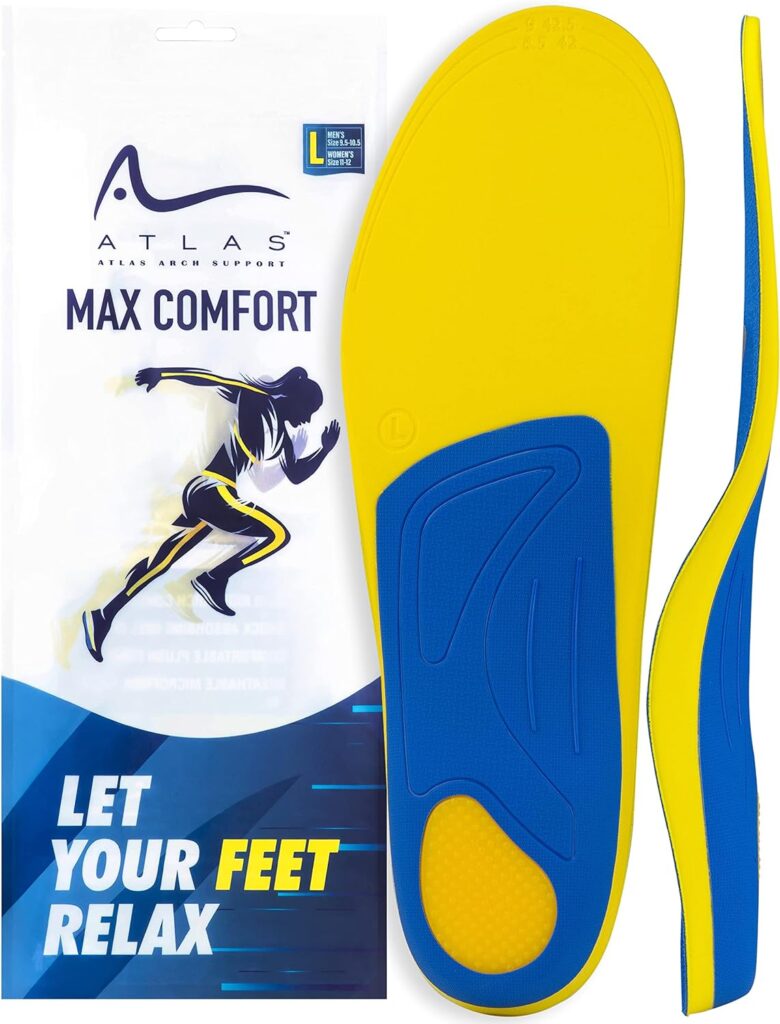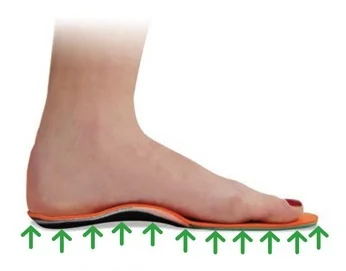Plantar Fasciitis is a common foot condition causing heel pain, often alleviated by using the right shoe inserts. This guide explores the benefits and usage of shoe inserts specifically for Plantar Fasciitis.
Article Outline
- Choosing the Right Shoe Inserts
- Factors to Consider
- Recommendations for Different Foot Types
- How to Use Shoe Inserts Effectively
- Correct Placement and Adjustment
- Tips for Getting Accustomed
- Combining Shoe Inserts with Other Treatments
- Complementary Therapies and Exercises
- Professional Advice and Custom Options
- Maintaining Your Shoe Inserts
- Cleaning and Care
- When to Replace Them
- Real-Life Success Stories
- Testimonials and Case Studies
WHERE TO BUY
- Testimonials and Case Studies
Choosing the Right Shoe Inserts
When it comes to managing Plantar Fasciitis, one of the most effective non-surgical approaches is selecting the right shoe inserts. These specialized inserts can significantly reduce pain and discomfort, enhancing your daily mobility and overall foot health. Here’s what you need to know to make an informed choice:
- Understand Your Foot Arch Type: Everyone’s feet are unique, and understanding your arch type is crucial. There are generally three types of foot arches – low, normal, and high. Each type may require a different kind of support. For instance, high arches might need more cushioning to absorb shock, while low arches may benefit from more structured support.
- Material Matters: Shoe inserts are made from various materials like gel, foam, plastic, or a combination. Each material offers different levels of support and comfort. Foam inserts provide cushioning and are great for pressure relief, whereas gel inserts are excellent for shock absorption. Rigid materials like plastic provide structured arch support.
- Consider the Size and Fit: An insert that doesn’t fit your shoe properly can be uncomfortable and ineffective. Ensure that the insert fits the length and width of your shoe. Some inserts are full-length, while others are ¾ length or just heel cups. Full-length inserts are generally more suitable for sneakers and casual shoes, while shorter inserts might fit better in dress shoes.
- Activity-Specific Inserts: If you’re an athlete or someone who stands a lot at work, consider inserts designed for specific activities. Inserts for running shoes, for example, might have different cushioning zones and support areas compared to those meant for walking or standing all day.
- Check for Special Features: Some inserts come with extra features like heat-moldability, which allows them to conform to the unique shape of your foot, or anti-microbial coatings to prevent odor.
- Consult with a Professional: If you’re unsure, it’s always a good idea to consult with a podiatrist. They can recommend the best type of insert based on your specific condition, foot structure, and lifestyle needs.
- Trial and Adjustment Period: It might take some time to get used to new inserts. Start by wearing them for short periods and gradually increase the duration. If you experience discomfort or pain, consult with a professional for adjustments.
Why Atlas Arch Support is Your Best Choice
Choosing the right arch support insole is crucial for foot health, especially for those with high arches. Atlas Arch Support stands out as an excellent choice for several reasons:
- Customized Fit and Support: Atlas Arch Support insoles are designed to cater to the unique contours of your feet. This customization ensures that the arch of each foot receives the correct amount of support, enhancing comfort and stability.
- Superior Material Quality: These insoles are crafted from high-grade materials that provide a perfect balance between cushioning and firmness. This combination is essential for high arches, as it provides the necessary support while also ensuring comfort.
- Durability and Longevity: Atlas insoles are known for their durability. Investing in a pair means you’re getting a product that will last and maintain its supportive qualities over time, making them a cost-effective choice in the long run.
- Versatility in Use: Whether you’re an athlete, someone who stands for extended periods, or simply looking for everyday comfort, Atlas Arch Support insoles are versatile enough to meet various needs and shoe types.
- Enhanced Alignment and Posture: By providing proper arch support, these insoles help in aligning your feet correctly, which can positively impact your overall posture and reduce strain on your knees, hips, and back.
- Proven Effectiveness for High Arches: Atlas Arch Support is specifically designed for high arches, addressing the common issues and discomforts associated with this foot type.
- Positive Customer Feedback: The brand has garnered positive reviews from users who have experienced significant improvements in foot comfort and reduction in pain associated with high arches.
In conclusion, Atlas Arch Support insoles present a blend of customized support, material quality, durability, and versatility, making them an ideal choice for those seeking relief and comfort for high arches.

How to Use Shoe Inserts Effectively
Using shoe inserts effectively for Plantar Fasciitis relief involves more than just placing them in your shoes. It requires an understanding of how they function and how to adapt to them for maximum benefit. Here are key steps to ensure you’re using your shoe inserts effectively:
- Proper Placement: Firstly, ensure that the inserts are placed correctly in your shoes. The arch support should align with the natural arch of your feet. If the insert is full-length, it should fit snugly against the back of the shoe. Trimming might be necessary for a perfect fit.
- Gradual Introduction: If you’re new to using shoe inserts, it’s important to give your feet time to adjust. Start by wearing them for a few hours each day and gradually increase the duration. This gradual approach helps your feet adapt without causing additional strain.
- Wear Suitable Shoes: Not all shoes are suitable for inserts. Use shoes with enough depth and a removable insole if possible. Avoid tight-fitting or high-heeled shoes as they can negate the benefits of the inserts.
- Check for Comfort and Support: Pay attention to how your feet feel while wearing the inserts. You should feel supported, but not to the point of discomfort. If you feel any pain, discomfort, or pressure points, the inserts may not be fitting correctly.
- Regular Breaks and Stretching: Especially in the beginning, take regular breaks to rest your feet and do stretching exercises. Stretching can help ease the symptoms of Plantar Fasciitis and complement the use of shoe inserts.
- Monitor Your Progress: Keep track of any changes in your symptoms. If your pain doesn’t improve or worsens, consult a healthcare professional. Sometimes, adjustments or a different type of insert may be necessary.
- Maintain Good Foot Hygiene: Keep both your feet and your shoe inserts clean to prevent any foot health issues. Clean your inserts according to the manufacturer’s instructions to maintain their effectiveness and longevity.
- Consistency is Key: To reap the full benefits, wear your inserts consistently. Switching back and forth between shoes with and without proper support can hinder your progress in managing Plantar Fasciitis.
Combining Shoe Inserts with Other Treatments
Effectively managing Plantar Fasciitis often requires a multi-faceted approach, and combining shoe inserts with other treatments can significantly enhance pain relief and healing. Here’s how you can integrate various therapies with the use of shoe inserts:
- Physical Therapy: Physical therapy is an essential component in treating Plantar Fasciitis. Therapists can provide specific exercises to stretch and strengthen the plantar fascia and Achilles tendon. These exercises, when combined with the support from shoe inserts, can help in reducing stress on the plantar fascia.
- Stretching Exercises: Regular stretching of the calf muscles and plantar fascia can relieve the symptoms of Plantar Fasciitis. Simple exercises like towel stretches, calf stretches, and plantar fascia stretches can be done at home. Performing these exercises in conjunction with wearing shoe inserts can lead to more effective pain relief.
- Night Splints: Night splints keep the foot in a dorsiflexed position during sleep, which helps in lengthening the plantar fascia and Achilles tendon overnight. Using night splints in addition to wearing supportive shoe inserts during the day can speed up the recovery process.
- Ice Therapy: Applying ice to the affected area can reduce pain and inflammation. Use an ice pack or a frozen bottle of water to roll under the foot for about 15-20 minutes, three or four times a day, especially after activities. This can be a great complement to the cushioning and support provided by shoe inserts.
- Orthotic Devices: Custom orthotics designed by a podiatrist can provide targeted support and cushioning based on your specific foot structure. While more expensive than over-the-counter shoe inserts, they can be highly effective when combined with other treatment modalities.
- Anti-inflammatory Medications: Over-the-counter nonsteroidal anti-inflammatory drugs (NSAIDs) like ibuprofen or naproxen can help reduce pain and inflammation. These medications can be used in conjunction with shoe inserts, especially during periods of intense pain.
- Lifestyle Modifications: Adjusting activities to avoid exacerbating the foot pain is crucial. Activities that put excessive strain on the foot like running or jumping should be minimized. Instead, opt for low-impact exercises like swimming or cycling. Pairing these lifestyle changes with the continuous use of shoe inserts can prevent further aggravation of Plantar Fasciitis.
- Weight Management: If you are carrying extra weight, reducing it can lessen the pressure on your feet. Combining weight loss efforts with the use of shoe inserts can significantly relieve the symptoms of Plantar Fasciitis.
Maintaining Your Shoe Inserts
Proper maintenance of your shoe inserts is crucial for ensuring they remain effective and hygienic. Well-cared-for inserts can last longer and continue to provide the necessary support and comfort for your Plantar Fasciitis. Here are some tips on how to maintain your shoe inserts:
- Regular Cleaning: Regularly clean your inserts to remove dirt, sweat, and bacteria. Most foam and fabric inserts can be gently hand-washed with mild soap and warm water. Avoid using harsh detergents or soaking them for too long, as this can damage the material.
- Drying Properly: After washing, allow your shoe inserts to air dry completely before placing them back in your shoes. Do not expose them to direct heat sources like radiators or hairdryers, as high heat can warp or shrink the material.
- Alternate Use: If you wear shoe inserts daily, consider having two pairs that you can alternate between. This gives each pair time to air out and can prevent the buildup of moisture and odor.
- Odor Control: To manage odor, you can sprinkle baking soda on the inserts and let them sit overnight before dusting it off. Some inserts also come with anti-odor treatments, but if yours don’t, you can use over-the-counter foot powders or sprays.
- Check for Wear and Tear: Regularly inspect your inserts for signs of wear and tear. Over time, inserts can lose their shape and support. Look for signs like thinning, cracks, or the breakdown of the material.
- Proper Storage: When not in use, store your shoe inserts in a cool, dry place away from direct sunlight. Exposure to sunlight and heat can deteriorate the materials used in many inserts.
- Following Manufacturer’s Instructions: Always adhere to the care instructions provided by the manufacturer. Different materials may require different care methods.
- Replacement When Necessary: Even with good care, shoe inserts will eventually need to be replaced. Pay attention to how your feet feel. If you start to notice a return of discomfort or pain, it might be time for a new pair.
